Neema Davis
A Framework for End-to-End Deep Learning-Based Anomaly Detection in Transportation Networks
Nov 20, 2019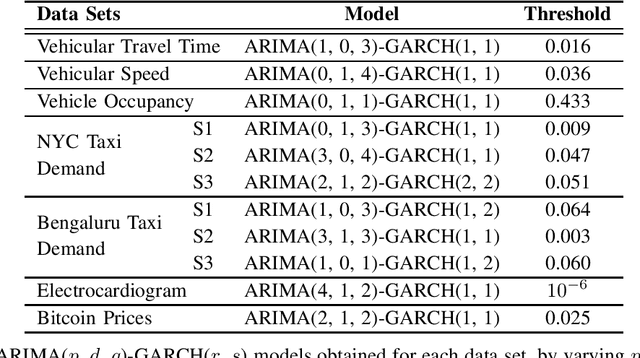
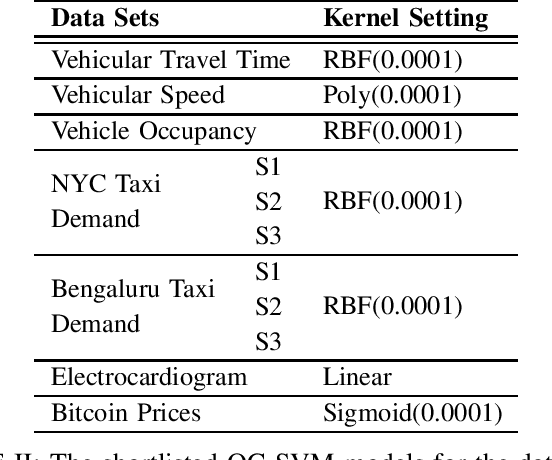
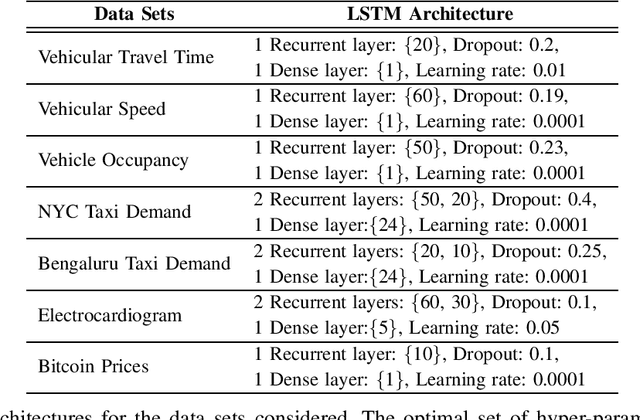
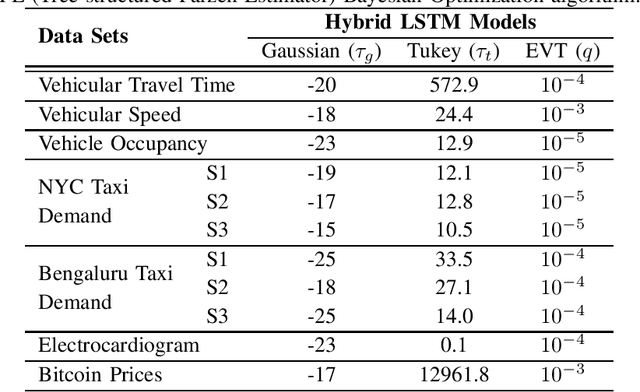
Abstract:We develop an end-to-end deep learning-based anomaly detection model for temporal data in transportation networks. The proposed EVT-LSTM model is derived from the popular LSTM (Long Short-Term Memory) network and adopts an objective function that is based on fundamental results from EVT (Extreme Value Theory). We compare the EVT-LSTM model with some established statistical, machine learning, and hybrid deep learning baselines. Experiments on seven diverse real-world data sets demonstrate the superior anomaly detection performance of our proposed model over the other models considered in the comparison study.
LSTM-Based Anomaly Detection: Detection Rules from Extreme Value Theory
Sep 13, 2019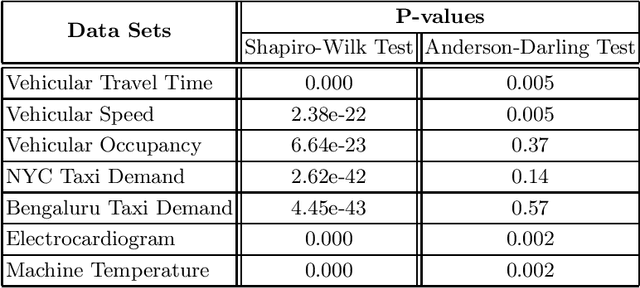
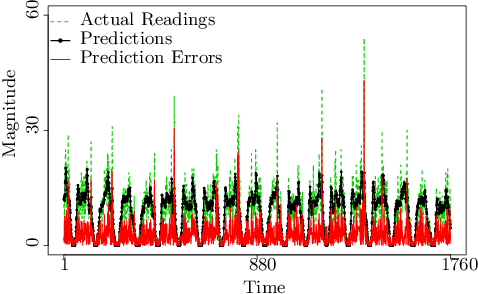


Abstract:In this paper, we explore various statistical techniques for anomaly detection in conjunction with the popular Long Short-Term Memory (LSTM) deep learning model for transportation networks. We obtain the prediction errors from an LSTM model, and then apply three statistical models based on (i) the Gaussian distribution, (ii) Extreme Value Theory (EVT), and (iii) the Tukey's method. Using statistical tests and numerical studies, we find strong evidence against the widely employed Gaussian distribution based detection rule on the prediction errors. Next, motivated by fundamental results from Extreme Value Theory, we propose a detection technique that does not assume any parent distribution on the prediction errors. Through numerical experiments conducted on several real-world traffic data sets, we show that the EVT-based detection rule is superior to other detection rules, and is supported by statistical evidence.
Grids versus Graphs: Partitioning Space for Improved Taxi Demand-Supply Forecasts
Feb 18, 2019



Abstract:Accurate taxi demand-supply forecasting is a challenging application of ITS (Intelligent Transportation Systems), due to the complex spatial and temporal patterns. We investigate the impact of different spatial partitioning techniques on the prediction performance of an LSTM (Long Short-Term Memory) network, in the context of taxi demand-supply forecasting. We consider two tessellation schemes: (i) the variable-sized Voronoi tessellation, and (ii) the fixed-sized Geohash tessellation. While the widely employed ConvLSTM (Convolutional LSTM) can model fixed-sized Geohash partitions, the standard convolutional filters cannot be applied on the variable-sized Voronoi partitions. To explore the Voronoi tessellation scheme, we propose the use of GraphLSTM (Graph-based LSTM), by representing the Voronoi spatial partitions as nodes on an arbitrarily structured graph. The GraphLSTM offers competitive performance against ConvLSTM, at lower computational complexity, across three real-world large-scale taxi demand-supply data sets, with different performance metrics. To ensure superior performance across diverse settings, a HEDGE based ensemble learning algorithm is applied over the ConvLSTM and the GraphLSTM networks.
Taxi Demand-Supply Forecasting: Impact of Spatial Partitioning on the Performance of Neural Networks
Dec 10, 2018
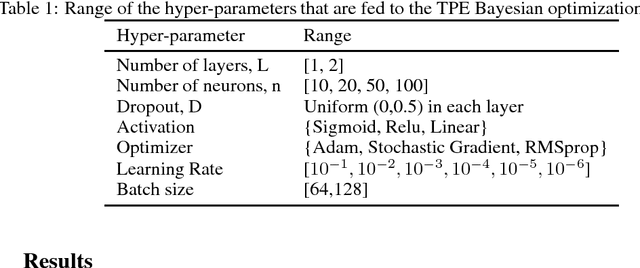
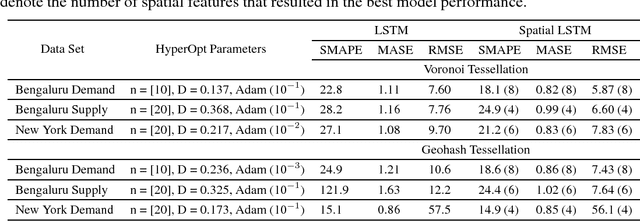
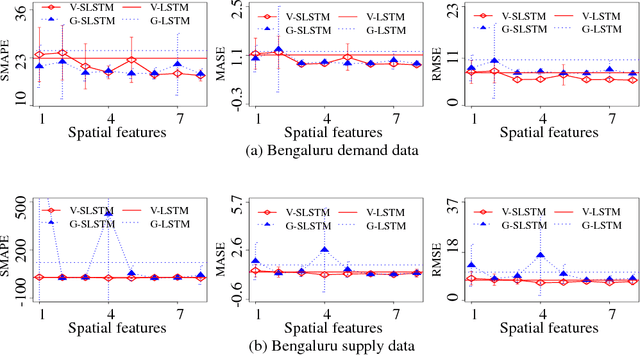
Abstract:In this paper, we investigate the significance of choosing an appropriate tessellation strategy for a spatio-temporal taxi demand-supply modeling framework. Our study compares (i) the variable-sized polygon based Voronoi tessellation, and (ii) the fixed-sized grid based Geohash tessellation, using taxi demand-supply GPS data for the cities of Bengaluru, India and New York, USA. Long Short-Term Memory (LSTM) networks are used for modeling and incorporating information from spatial neighbors into the model. We find that the LSTM model based on input features extracted from a variable-sized polygon tessellation yields superior performance over the LSTM model based on fixed-sized grid tessellation. Our study highlights the need to explore multiple spatial partitioning techniques for improving the prediction performance in neural network models.
Taxi demand forecasting: A HEDGE based tessellation strategy for improved accuracy
May 29, 2018



Abstract:A key problem in location-based modeling and forecasting lies in identifying suitable spatial and temporal resolutions. In particular, judicious spatial partitioning can play a significant role in enhancing the performance of location-based forecasting models. In this work, we investigate two widely used tessellation strategies for partitioning city space, in the context of real-time taxi demand forecasting. Our study compares (i) Geohash tessellation, and (ii) Voronoi tessellation, using two distinct taxi demand datasets, over multiple time scales. For the purpose of comparison, we employ classical time-series tools to model the spatio-temporal demand. Our study finds that the performance of each tessellation strategy is highly dependent on the city geography, spatial distribution of the data, and the time of the day, and that neither strategy is found to perform optimally across the forecast horizon. We propose a hybrid tessellation algorithm that picks the best tessellation strategy at each instant, based on their performance in the recent past. Our hybrid algorithm is a non-stationary variant of the well-known HEDGE algorithm for choosing the best advice from multiple experts. We show that the hybrid tessellation strategy performs consistently better than either of the two strategies across the data sets considered, at multiple time scales, and with different performance metrics. We achieve an average accuracy of above 80% per km^2 for both data sets considered at 60 minute aggregation levels.
 Add to Chrome
Add to Chrome Add to Firefox
Add to Firefox Add to Edge
Add to Edge